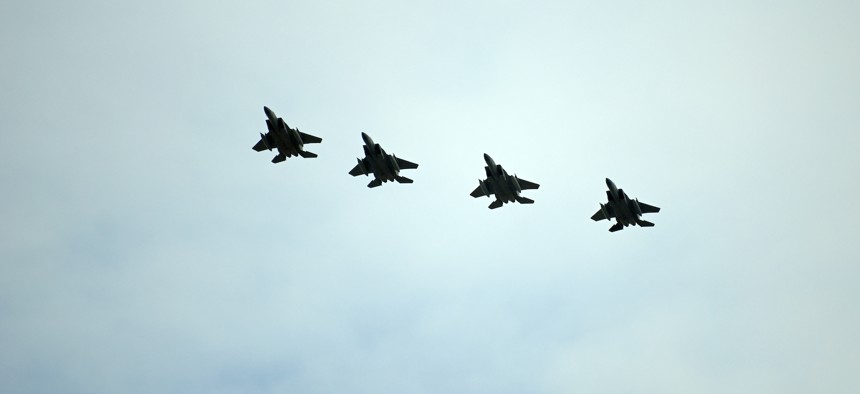
Four U.S. Air Force F-15 Eagles from the 173rd Fighter Wing, Oregon Air National Guard, return from a training mission with F-35 Lightning II aircraft from Luke Air Force Base, Arizona lands on the runway at Kingsley Field in Klamath Falls, Oregon October 26, 2023. U.S. Air Force / Senior Master Sgt. Jennifer Shirar
F-35 engine upgrade on track, despite congressional dysfunction
Pratt & Whitney plans to start delivering the upgraded engines by 2029.
The Pentagon’s effort to upgrade the F-35’s engine is still on track, despite warnings from Air Force leaders that the program could run out of money due to an impasse in Congress stalling the fiscal 2024 budget.
Engine-maker Pratt & Whitney doesn’t foresee a continuing resolution delaying the company’s plan of getting the upgraded engines into the fleet by 2029, Jen Latka, vice president of Pratt’s F135 program, told reporters Tuesday. However, the company has not worked out what might happen if Congress fails to pass any spending bills and sequestration cuts kick in.
“Like all programs, the continuing resolution has the potential to have an impact. We have not worked through all the details if we had a sequestration scenario. What I know now is that our schedule is on track, that we have identified funding to continue. That's not to say that that situation cannot change,” Latka said.
The program, called Engine Core Upgrade, or ECU, is in its preliminary design phase, and will wrap up its official review in May, Latka said—a few months behind its previous target of January. The design phase will finish in mid-2025, and the company is slated to test the first engine in 2026, she said. Pratt plans to start delivering the finished engine upgrade by 2029.
Designed to be “100 percent digital,” Pratt is using a digital model of the engine to save time and easily make design changes. “We are working in a model-based systems engineering environment with ECU, so if we make one little design tweak to a part, it is running through an integrated model, all the structures analysis, all the thermals analysis, etc. It's all being done in an integrated model,” she said.
Once the upgrade is ready, replacing the power modules in the jets will be fairly simple, Latka said.
“ECU will be the engine in the new jets that are coming off Lockheed’s production line, but we will also be retrofitting in the depo and we could also retrofit and swap modules on the flight line, so there's a lot of different ways that ECU can go and get fielded quickly,” Latka said.
In addition to the engine upgrade, the jet also needs an upgrade to its cooling system to handle future upgrades to the jet. The Pentagon hasn’t yet decided if it will launch a competition for the cooling system, but Honeywell, which makes the current cooling system, and Collins Aerospace, which would offer a new system, have already discussed their plans to position themselves for a future competition. Collins and Pratt are both subsidiaries of RTX.
Regardless of whether the jet keeps its current cooling system or is upgraded, Latka said ECU will enable “any and all” Power and Thermal Management System solutions.
“It is being designed to drop into the existing jet that is out there today. It's retrofittable, so you can do nothing to the PTMS solution and you can retrofit with ECU. On the other hand, if Lockheed and JPO and all of the services and customers decide to put in an upgraded PTMS solution or a clean sheet new PTMS solution because they want more kilowatts, ECU will fully enable that,” Latka said.
Engines for USAF’s next-gen fighter
As Pratt finishes designing the F-35 engine upgrade, it’s also working on an engine to power the Air Force’s future fighter jets under a highly classified program called Next Generation Adaptive Propulsion, or NGAP. The service is funding two vendors—Pratt and General Electric—through the next-gen engine prototyping stage.
Pratt is “making progress” on the engine design and is in the “prototyping phase, and that will carry late into the decade,” said Jill Albertelli, president of Pratt’s military engines.
The company is relying heavily on digital prototyping for NGAP, but there will also be physical engine prototyping before the end of the decade, Albertelli said.
Digital tooling allows the company to iterate, but digital won’t completely supplant engine testing, Albertelli said. How far the digital design will go before physical engines are built remains to be seen, but Pratt executives said they are using digital for more than just design.
“Think of it as digital is a requirement as part of the program for prototyping. Digital doesn't just stop with design. It also then, of course, goes into manufacturing and inspection, so you take your model and you work with your shop or your supplier, and you use that digital model to actually create the hardware,” Albertelli said.


